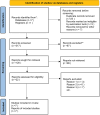Association between CCL5, CCL11, and CCL17 polymorphisms and atopic dermatitis risk: A systematic review and meta-analysis
- PMID: 38394497
- PMCID: PMC11309614
- DOI: 10.1097/MD.0000000000036897
Association between CCL5, CCL11, and CCL17 polymorphisms and atopic dermatitis risk: A systematic review and meta-analysis
Abstract
Background: Atopic dermatitis (AD) is a common and recurrent inflammatory disease with strong genetic susceptibility. The abnormal production of chemokines plays an important role in the occurrence and development of AD.
Methods: A comprehensive online literature search was performed in databases of China National Knowledge Infrastructure, Wanfang, VIP China Science and Technology Journal Database, China Biomedical Literature Database, PubMed, Embase and Cochrane Library to retrieve relevant articles published from January 2000 to October 2022. The odds ratio (OR) with its 95% confidence interval (CI) was employed to calculate this relationship.
Results: A total of 7 studies were finally screened out, including 1316 AD patients and 1099 controls. There were 3 studies for CC chemokine ligand 5 (CCL5) polymorphisms, 2 for CCL11 polymorphisms, and 2 for CCL17 polymorphisms, respectively. The meta-analysis revealed a significant association between the CCL5 - 403G/A polymorphism and AD under the allelic model (A vs G: OR = 1.25, 95% CI = 1.02-1.52, P = .03), heterozygous model (AG vs GG: OR = 1.40, 95% CI = 1.08-1.80, P = .01) and dominant model (AA + AG vs GG: OR = 1.38, 95% CI = 1.08-1.76, P = .01) in a fixed-effect model. The allelic model (G vs C: OR = 1.46, 95% CI = 1.07-1.98, P < .01) and dominant model (GG + GC vs CC: OR = 1.74, 95% CI = 1.23-2.47, P < .001) of the CCL5 - 28C/G polymorphism were also associated with an increased risk of AD. However, this significant association was not found in other alleles and genotypes (P > .05).
Conclusion: Our results show that the A allele, AG and AA + AG genotypes of the CCL5 - 403G/A polymorphism, the G allele and GG + GC genotype of the CCL5 - 28C/G polymorphism are risk factors for AD. Future studies with large population are still needed to further explore those correlations.
Copyright © 2024 the Author(s). Published by Wolters Kluwer Health, Inc.
Conflict of interest statement
The authors have no conflicts of interest to disclose.
Figures







Similar articles
-
RANTES gene polymorphisms are not associated with rheumatoid arthritis and atopic dermatitis: a meta-analysis.Int Rev Immunol. 2015;34(6):500-8. doi: 10.3109/08830185.2014.994815. Epub 2015 Jan 21. Int Rev Immunol. 2015. PMID: 25607251 Review.
-
Association of RANTES gene polymorphisms with susceptibility to childhood asthma: A meta-analysis.Medicine (Baltimore). 2020 Jul 17;99(29):e20953. doi: 10.1097/MD.0000000000020953. Medicine (Baltimore). 2020. PMID: 32702834 Free PMC article.
-
Association between CC motif chemokine ligand 5 (CCL5) polymorphisms and asthma risk: an updated meta-analysis.J Investig Allergol Clin Immunol. 2015;25(1):26-33. J Investig Allergol Clin Immunol. 2015. PMID: 25898691
-
The regulated upon activation normal T-cell expressed and secreted (RANTES) -28C/G and -403G/A polymorphisms and asthma risk: a meta-analysis.Mol Diagn Ther. 2014 Oct;18(5):523-31. doi: 10.1007/s40291-014-0112-5. Mol Diagn Ther. 2014. PMID: 25004906 Review.
-
A genetic association study of CCL5 -28 C>G (rs2280788) polymorphism with risk of tuberculosis: a meta-analysis.PLoS One. 2013 Dec 23;8(12):e83422. doi: 10.1371/journal.pone.0083422. eCollection 2013. PLoS One. 2013. PMID: 24376699 Free PMC article.
Cited by
-
Ziziphus jujuba Miller Ethanol Extract Restores Disrupted Intestinal Barrier Function via Tight Junction Recovery and Reduces Inflammation.Antioxidants (Basel). 2024 May 7;13(5):575. doi: 10.3390/antiox13050575. Antioxidants (Basel). 2024. PMID: 38790680 Free PMC article.
-
Multi-omics investigation of prospective therapeutic targets for type 1 diabetes.Ther Adv Endocrinol Metab. 2025 May 7;16:20420188251337988. doi: 10.1177/20420188251337988. eCollection 2025. Ther Adv Endocrinol Metab. 2025. PMID: 40342965 Free PMC article.
-
Association of +67 G/A and -426 T/C Polymorphism in Eotaxin (CCL11) Gene with Psoriasis Phenotypes.Genes (Basel). 2025 Feb 27;16(3):288. doi: 10.3390/genes16030288. Genes (Basel). 2025. PMID: 40149440 Free PMC article.
References
-
- Sabin BR, Peters N, Peters AT. Chapter 20: atopic dermatitis. Allergy Asthma Proc. 2012;33(Suppl 1):67–9. - PubMed
-
- Jordan HF, Todd G, Sinclair W, et al. . Aetiopathogenesis of atopic dermatitis. S Afr Med J. 2014;104:706–9. - PubMed
-
- Mancini AJ, Kaulback K, Chamlin SL. The socioeconomic impact of atopic dermatitis in the United States: a systematic review. Pediatr Dermatol. 2008;25:1–6. - PubMed
-
- Williams H, Flohr C. How epidemiology has challenged 3 prevailing concepts about atopic dermatitis. J Allergy Clin Immunol. 2006;118:209–13. - PubMed
-
- Flohr C, Mann J. New insights into the epidemiology of childhood atopic dermatitis. Allergy. 2014;69:3–16. - PubMed
Publication types
MeSH terms
Substances
LinkOut - more resources
Full Text Sources
Molecular Biology Databases
Miscellaneous

